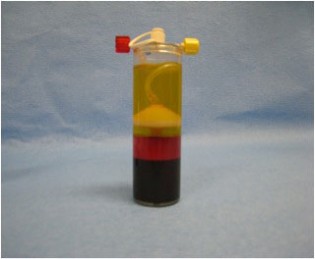
Harnessing and using your horse's own cells to help them heal! The goal of regenerative medicine is to get a more normal and faster healing response to tendon, ligament, and joint injuries. Depending on your horse's injury one or more of the below therapies may be recommended.
Now offering ProStride which is a PRP/IRAP combo stall side joint therapy product.
Platelet-rich plasma ( PRP) is blood plasma taken from your own horse's blood and that has been spun in a centrifuge to concentrate the platelets. As a concentrated source of autologous platelets, PRP contains (and releases through degranulation of the platelets) several different growth factors and other cytokines that stimulate healing of bone and soft tissue. It is used mostly in the acute injury of tendons, ligaments, joints, and meniscal injuries to improve the speed and quality of healing that occurs. It may also be helpful in more chronic or older conditions and injuries to help with and improve healing as well.
Stem Cells are derived from your horse's own bone marrow or from adipose(fat) tissue. When it comes from your own horse it is called autologous. They can also come from universal donor horses called allogenic stem cells derived from the bone marrow of the donor horse. I primarily use the donor stem cells due to the fact there is no need to acquire the cells from your own horse and they can be shipped immediately when needed for quicker treatment. Also, the cost of donor cells is less than autologous stem cells as well, and the chance of rejection is very unlikely. Stem cells work very similar to PRP by using the stem cells chemotactic factors and cytokines to attract the bodies own healing cells to the area to improve the quality of healing that occurs post injury. They are also used to treat tendon, ligament, joint, and meniscal injuries.
IRAP(Interleukin-1 Receptor Antagonist Protein), A common cause of lameness in the horse is osteoarthritis or degenerative joint disease from joint injury, developmental joint disease, and repetitive trauma to joints. Some clinical signs of osteoarthritis are lameness, joint swelling and inflammation. Cartilage damage is a common cause of this inflammation. Joint trauma and inflammation results in the release of inflammatory mediators such as IL-1 and other catabolic cytokines that further the breakdown of cartilage and cause the progression of osteoarthritis. In a health joint there is an equal balance of good anabolic cytokines that help stop inflammation within the joint. In a diseased joint the bad cytokines like IL-1 overcome the good cytokines and cause progression of the disease. So, this is where IRAP comes into affect. By harnessing IL-1 antagonist from your horse's own blood by incubating the blood in a special tube with glass beads overnight that cause cells to produce IL-1 antagonist. The serum containing the IL-1 antagonist is draw off and then used to inject back into your horse's joint to counteract the overproduction of IL-1 in the joint. This helps stop the inflammation within the joint and stop the deleterious affect of IL-1. IRAP is your horse's own natural way to control inflammation within the joint without the use of steriods which over time can have deleterious affects on articular cartilage if given frequently. So, IRAP is a good way of maintaining joint health, reducing inflammation, and decreasing the use of steriods in the joint. I recommend IRAP for use in horses that need to be treated frequently for osteoarthritis of a particular joint, those that are not responding to steriods any longer, and during the show season if drug testing is an issue. The usual treatment schedule is weekly treatments for 3 weeks then to use as needed. Each IRAP kit can harness enough serum for 3 to 6 injections depending on the kit used for collection. The first dose is usually put in right after collection. The remaining doses are frozen and store for future injections.

